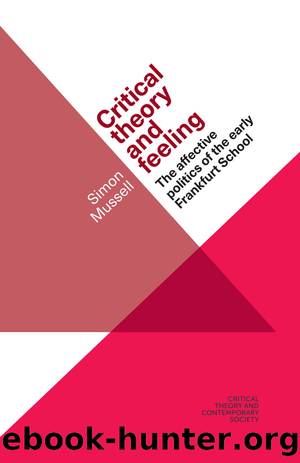Critical Theory and Feeling by Mussell Simon

Author:Mussell, Simon
Language: eng
Format: epub
Publisher: Manchester University Press
3
A feeling for things: objects, affects, mimesis
And things, what is the correct attitude to adopt towards things?
â Samuel Beckett, The Unnameable
Recent years have seen an explosion of scholarly interest in things. From the ânew materialismsâ to âobject-oriented ontologyâ, from âthing theoryâ to âactor-network theoryâ, much of contemporary thought is turning its attention to the world of objects. What are the reasons for this shift? One of the principal motivations behind the turn to objects is a reaction against the âcultural turnâ and its subject-centred, discursive, âcriticalâ modes of textual interpretation and constructivism. These dominant models of thinking are said to overlook the myriad ways in which non-human matter is in itself irreducibly complex, productive, vibrant, dynamic, and so on. Another reason for the proliferation of object-oriented approaches is the growing awareness of ecological threats associated with the changing climate, whose grave implications seem to dwarf the significance and figure of the human being. Indeed, such a rejection of anthropocentric perspectives and methodologies is common to most object-led theory. For the range of thinkers from various backgrounds and disciplines who have contributed to this rethinking of the object world, no longer is the object to be understood simply in contradistinction, or epistemological service, to a human subject. Rather, against the prohibitions set out by Kant, the aim of many of todayâs prominent thought-dispensers is precisely to think an object in- and for-itself.
This last ambition undergirds the ideas loosely collected under the banner of âobject-oriented ontologyâ (OOO), also known as âspeculative realismâ (SR). In this chapter, I want to show how the contemporary (re)turn to objects initially serves as a useful corrective to social or political theories that fail to properly engage with the object world (this includes forms of traditional Marxism that often presume âreificationâ to be a perennial evil, rather than a particular social relation). I take this as an opportunity for a timely reconstruction of early critical theoryâs own engagements with the object world via aesthetics and mimesis. This is most evident in Siegfried Kracauerâs materialist film theory, as well as in Adornoâs theories of mimetic comportment and the preponderance of the object. Drawing out the affective qualities of critical theoryâs relation to objects in this way not only challenges the Marxist orthodoxy that subordinates issues around objects and aesthetics; it will also serve as a rejoinder to todayâs self-appointed envoys for the object world. My aim is to demonstrate that despite the considerable hype surrounding its leading proponents, OOO/SR suffers from a severe political and historical deficit, rendering it a practice of passive description rather than active interpretation (let alone intervention). The work of early critical theory is shown to avoid the shortcomings evident in OOO by effectively mediating subjectivity and objectivity through aesthetics.
In order to properly situate and re-evaluate critical theoryâs engagement with objects, it is necessary to understand the dual dangers that accompany any theorization of objects. The first is that of excessive subjugation â evident in traditional, subject-centric political theory (including forms of orthodox Marxism).
Download
This site does not store any files on its server. We only index and link to content provided by other sites. Please contact the content providers to delete copyright contents if any and email us, we'll remove relevant links or contents immediately.
Spare by Prince Harry The Duke of Sussex(4195)
Machine Learning at Scale with H2O by Gregory Keys | David Whiting(2291)
Fairy Tale by Stephen King(2069)
Will by Will Smith(2041)
Hooked: A Dark, Contemporary Romance (Never After Series) by Emily McIntire(1959)
Rationality by Steven Pinker(1765)
The Bullet Journal Method by Ryder Carroll(1501)
The Becoming by Nora Roberts(1330)
Friends, Lovers, and the Big Terrible Thing by Matthew Perry(1327)
A Short History of War by Jeremy Black(1300)
HBR's 10 Must Reads 2022 by Harvard Business Review(1256)
The Strength In Our Scars by Bianca Sparacino(1245)
Can't Hurt Me: Master Your Mind and Defy the Odds - Clean Edition by David Goggins(1227)
515945210 by Unknown(1207)
Fear No Evil by James Patterson(1109)
Love on the Brain by Ali Hazelwood(1095)
Bewilderment by Richard Powers(1083)
This Family Does It by Kevin Sellers(1080)
443319537 by Unknown(1072)
